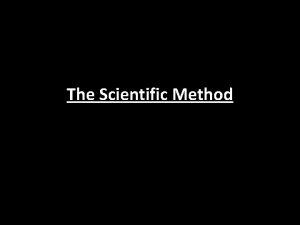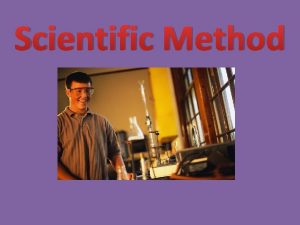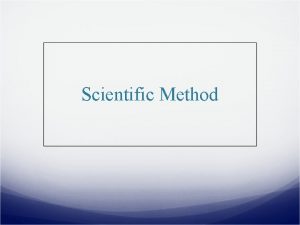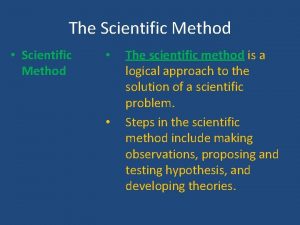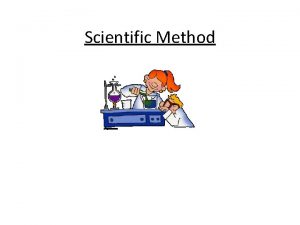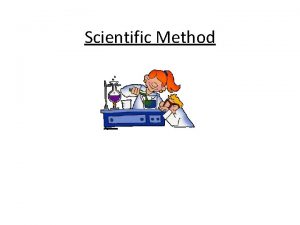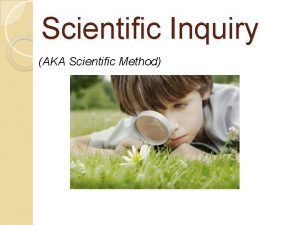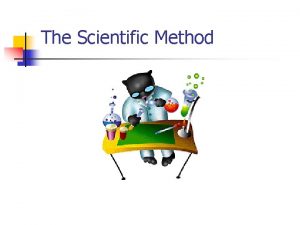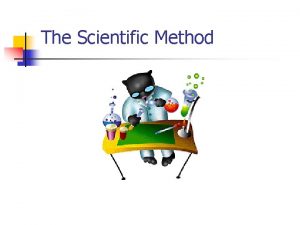The Scientific Method Scientific Method n The Scientific

















- Slides: 17

The Scientific Method

Scientific Method n The Scientific Method is a series of steps scientists use to answer questions and solve problems.

8 Steps 1. Ask a Question—find something you are curious about 2. Purpose—why are you interested in answering your question; who would care about what you find out? You need a question that is measureable and meaningful.

8 steps continued 3. Research your question—find facts that inform you about your question & help you make a hypothesis 4. Form a Hypothesis—an educated guess based on the facts you looked up

8 steps continued 5. Test the Hypothesis by performing an experiment 6. Analyze Results—look at your data

Final 8 steps 7. Draw Conclusions—decide if you were correct based on your data 8. Communicate Results

Pneumonic to remember the steps: Queens probably rarely have egg and doughnut cereal. Queens—question Probably—purpose Rarely—research Have—hypothesis Egg—experiment And—analyze data Doughnut—draw conclusions Cereal—communicate results

Question • • Pick a question/problem that is interesting to you Pick one that doesn’t involve testing on humans, with bacteria, explosives, or most weapons

Purpose n n What’s the point in doing your project? Pick a project that will be meaningful (helpful to many people, improving their lives, or solving problems/curing disease) and measurable with a metric unit of measurement. Bad example: Which ketchup brand comes out of the bottle faster? Good example: Which type of shingle resists high speed winds longer?

RESEARCH n You are looking for information that supports your hypothesis. n Research consists of information found in the following places: n n n Books Magazines Newspapers Encyclopedias Websites Interviews of experts

Form A Hypothesis n A hypothesis is a clear statement about what you think will happen based on your observations & research about your question. n A hypothesis is an educated guess. n Examples: n n A frozen tennis ball will bounce higher than a room temperature tennis ball. Acid rain will cause plants to grow more slowly than tap water.

Test your Hypothesis n Gather materials n Perform your experiment many times n Why? You have to make sure what you found out is true and not just luck. n Record data in data tables

Recording Data n Your data should be collected as soon as you get results, this will vary depending on your project. n You will use the metric system to take measurements. n Examples: n Meters/Centimeters n Seconds n Liters/milliliters n Grams/Kilograms n DO NOT USE INCHES, FEET, CUPS, POUNDS as these are English units not metric units.

Recording Data in Metric Units n The System International or Metric System is used by scientists all over the world. n Standard units of measurement: (You must know these. ) Length = meter n Volume (amount of liquid) = liter n Mass (weight) = gram n Time = second n

Analyze Results n Organize your data using graphs and tables n Then, explain those graphs in writing.

Draw Conclusions n You will discuss whether or not your results supported your hypothesis. n If your results do not support your hypothesis, you need to try to explain what could have happened in the experiments to influence your results.

Communicate Results n . You will present your findings in order for your experiment to have accomplished anything - if you cured cancer but didn’t report it then you didn’t do anything.
 Information gathered during an experiment
Information gathered during an experiment Hát kết hợp bộ gõ cơ thể
Hát kết hợp bộ gõ cơ thể Ng-html
Ng-html Bổ thể
Bổ thể Tỉ lệ cơ thể trẻ em
Tỉ lệ cơ thể trẻ em Voi kéo gỗ như thế nào
Voi kéo gỗ như thế nào Glasgow thang điểm
Glasgow thang điểm Alleluia hat len nguoi oi
Alleluia hat len nguoi oi Các môn thể thao bắt đầu bằng tiếng đua
Các môn thể thao bắt đầu bằng tiếng đua Thế nào là hệ số cao nhất
Thế nào là hệ số cao nhất Các châu lục và đại dương trên thế giới
Các châu lục và đại dương trên thế giới Cong thức tính động năng
Cong thức tính động năng Trời xanh đây là của chúng ta thể thơ
Trời xanh đây là của chúng ta thể thơ Mật thư tọa độ 5x5
Mật thư tọa độ 5x5 Phép trừ bù
Phép trừ bù độ dài liên kết
độ dài liên kết Các châu lục và đại dương trên thế giới
Các châu lục và đại dương trên thế giới Thể thơ truyền thống
Thể thơ truyền thống





















